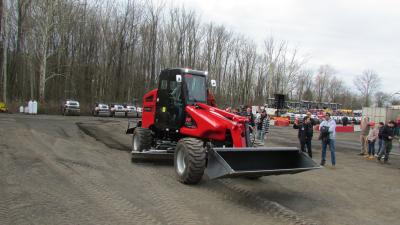The textile industry dominated South Carolina’s economics in the late 1800s and 1900s; however, due to international competition, by 1980 all the textile mills closed, creating ghost towns of abandoned factories with depressed surrounding neighborhoods.
Located in Rock Hill, S.C., is the textile corridor historic district; 250 acres of buildings associated with the city’s defunct cotton textile industry which was active between the years of 1880 to 1970. Rock Hill’s Economic and Urban Development plan hopes to revitalize the area by offering opportunities for private capital investment, public sector support and a wide array of living, working and recreating options while at the same time maintaining the historical integrity of the area.
Situated within the district is the Rock Hill Cotton Factory, which is listed on the National Register of Historic Places. The factory, which opened in 1881, was the first steam-driven textile cotton factory in South Carolina. Workers were recruited from all over the south and the population of Rock Hill increased from 900 to 25,000. The factory produced textile products until it closed in 1970. From 1970 to 2001, Plej’s Inc., a retail company specializing in overruns, occupied the building.
Current owners, Brian Barwick, Gary Williams and Bob Perrin, plan to restore the old factory under the guidelines of the South Carolina Textiles Communities Revitalization Act with plans to reopen the historic building for business and retail use.
The South Carolina Textiles Communities Revitalization Act provides financial incentives for the renovation, improvements and redevelopment of abandoned textile mill sites located in South Carolina.
According to Barwick, who also is the developer, this project qualifies for both the 10 percent state historic tax credit and the 20 percent federal income tax credit for the rehabilitation of historic income-producing properties.
“In order to qualify for the federal and state tax credits the work must follow strict historical constraints with particular concern being that the building’s exterior be restored to exactly how it looked in 1881,” explained Barwick. “In addition, restoration plans had to be sent to the South Carolina Department of Archives, which forwarded them to the Department of Interior for final approval before moving forward with the demolition and restoration of the project.”
General contractor for the $10-million restoration project is Cox & Schepp Construction Inc. of Charlotte, N.C. Handling the design work is the architecture firm of McClure, Nicholson and Montgomery, located in Charlotte, N.C.
The 100,000-sq.-ft. mill has areas that are one to three stories high with brick exterior, wood timber interior and steel beam construction.
Approximately 15,000 sq. ft. of the mill were considered non-historical.
Non-Historic Additions Demolished
According to Eric Bartruff, vice president of Big Dog Demolition, the firm demolished and removed the additions that had been made to the original mill. Demolition occurred in August 2006 and took two weeks to complete. There were approximately 30 Big Dog employees at the job site daily.
“Working with buildings over 100 years old is always challenging,” Bartruff said. “Numerous safety precautions must be implemented so as not to damage the historic building — this includes using the right tools, equipment and experienced people.
“In order to free the additions, which were secured to the original buildings with steel girders, Genesis shear hydraulic attachments, connected to Case 330 excavators [owned by Big Dog] snipped the girders — almost like a sharp pair of scissors — freeing the addition from the original building,” explained Bartruff. “After the separation, excavators were used to pull the additions away from the original structure. The steel girder stubs left behind in the walls of the old factory were then removed by hand.”
Approximately 100,000 lbs. of steel was recovered from the site.
“This steel was sent to a local scrap yard for recycling,” continued Bartruff. “Approximately 400 cubic yards of brick was recovered; this brick was sent to Westinghouse Materials of Charlotte, North Carolina, where it will be ground down and reused as fill or road base.”
Once the demolition is complete the general contractor will be responsible for the shoring of the newly exposed wall of the historic building.
Big Dog prepared the interior of the historic building for restoration by taking the building down to a cold dark shell; this included removing old electrical and plumbing, removing the old floor, reopening boarded up windows, sandblasting old paint, and washing the brick.
According to Kevin Parks, project manager of Cox and Schepp, because of the historical significance of the building, pressuring washing was not allowed since it may blow the old mortar off; therefore detergent washing was required for both the interior and the exterior brick.
“After washing, grout is injected into the holes and fractures of the brick,” said Parks. “The brick will be painted with a brick red color, which was approved by the state historical agencies involved in reviewing the restoration plans.”
The goal of the exterior restoration plans is to return the building to the way it looked in 1881. In order to do this, the windows that had been sealed up over the years will be reopened and 260 new large windows will be installed. In addition, all new TPO roofing will be installed.
“Being part of the revitalization of the textile corridor of Rock Hill is what makes this project so interesting to me,” Parks said. “Textile manufacturing played a major role in the economic development of the area; restoring these historic buildings will not only improve the economic base of the community but save a real part of our history.
“In 1980, there were 16 mills in operation and 75,000 people in the county,” explained Williams. “Today we have one mill open and 200,000 people. The textile corridor has become vacant. The goal of the community, and this project, is to revitalize this area and turn it back into a productive center of the community.”
The restoration of the historic building began on Aug. 11, 2006, and should be complete on March 31, 2007. CEG
Today's top stories















